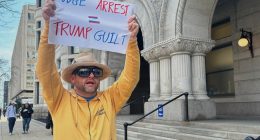By her own admission, Nicola Sturgeon is one of life’s catastrophisers – never fully convinced that disaster does not lurk around the next bend. In a sense, then, she has been preparing for a moment such as this all her political days.
‘What drives me is the Scottish fear of failure,’ she said early in her career.
Much later, during the final days of her First Ministership, her sense of foreboding was no less acute – despite exuding an abundance of self-belief throughout her career. ‘I’ve got a terrible dread about tempting fate,’ she said.
Today, it seems, the long anticipated catastrophe is at hand.
In her quarter century as an elected politician Ms Sturgeon can point to triumphs beyond the dreams of almost any other rival in Britain.


JONATHAN BROCKLEBANK: By her own admission, Nicola Sturgeon is one of life’s catastrophisers – never fully convinced that disaster does not lurk around the next bend


JONATHAN BROCKLEBANK: Without the surprise intervention of Alex Salmond – who announced his candidacy despite promising not to – she may never have led her party at all. Pictured: Salmond and Sturgeon close the SNP Conference with a kiss in 2012


JONATHAN BROCKLEBANK: Her battle with the UK Government’s section 35 veto of the Gender Recognition Reform Bill was, Mr Salmond commented in February, ‘a hill to die on’ and an unworthy one at that. Pictured: Transgender Isla Bryson at high court while on trial for raping two women
She led a party that won 53 out of the 56 seats it contested in the 2015 General Election.
That same year her approval ratings reached 71 per cent, higher than any other western leader, and she performed so surefootedly in the televised leaders debates that many English viewers Googled ‘can I vote for the SNP?’
Yet eight years later she stands humiliated, those career high points obliterated by the wreckage of her legacy as party leader and First Minister.
No one could dispute that Ms Sturgeon gave her heart and soul to her party. It could even be argued that she was married to it.
Yet she is today as closely associated with its current implosion as she was eight years ago with its lionisation.
The fear of failure which made her work harder and prepare more thoroughly than her colleagues or rivals helped propel her to the top.
But it brought downsides too. It made her controlling, occasionally aggressive, increasingly intolerant of dissent.
For all that she played up her humble Scottish roots, her hardworking parents and her local comp education, there were few more high and mighty than Ms Sturgeon in her pomp. From beginning to end she had the clipped air of someone who could not conceive of being wrong.
It was at Greenwood Academy, Ayrshire, that her political allegiances were established.
A teacher with allegiances of his own noted her developing social conscience and presented her with an application to join the Labour party.
The schoolgirl took exception to his presumptuousness.
S HE remembered: ‘That was the catalyst. I thought, ‘stuff you, I’m going to join the SNP.’ Later she would cite Margaret Thatcher as the motivation for her political colours. ‘I hated everything she stood for. This was the genesis of my nationalism.’
Her parents Robin and Joan were not fans either – despite taking advantage of the right-to-buy policy introduced by the then Prime Minister to purchase their council house for just £8,400.
She was the first member of her family to go to university – studying law at Glasgow – and was highly active in the SNP’s student wing.
Even before completing her finals in 1992 she was standing in the General Election of that year – then as the youngest Scottish candidate ever to do so.


JONATHAN BROCKLEBANK: No one could dispute that Ms Sturgeon gave her heart and soul to her party. It could even be argued that she was married to it. Pictured: Sturgeon and her husband Peter Murrell in 2022
She lost by some 15,000 votes in the Labour stronghold of Glasgow Shettleston.
And so, by necessity, a short-lived career outside politics began as she became a trainee at Glasgow firm McClure Naismith.
‘She just was not a star,’ a legal partner there would later recall. ‘She didn’t show any great ambition to do what we did.’
There was a brief stint at a Stirling law firm, followed by a post as an adviser at the Drumchapel Law Centre in Glasgow, which was better suited to her social justice concerns. A further tilt at Westminster followed in 1997 when she stood for Glasgow Govan.
But she was defeated this time by Labour’s Mohammad Sarwar, father of the current Scottish Labour leader Anas.
Ultimately, it would take the proportional representation built into the Holyrood election system to give her a seat in the inaugural Scottish parliament.
She lost to Gordon Jackson in the first-past-the-post race in 1999 but entered the parliament as a list MSP. The result was repeated in the 2003 election.
When she threw her hat in the ring to lead her party the following year, then, she was a veteran of four consecutive election defeats. While her mentor Alex Salmond had by then never lost a constituency election battle, she had never won one.
Indeed, it is widely accepted that Ms Sturgeon was about to lose the party leadership election too as rival candidate Roseanna Cunningham enjoyed greater support at the time.
Read Related Also: Pat Cummins relative allegedly stabbed at Macquarie Park train station and taunted by trolls
Without the surprise intervention of Alex Salmond – who announced his candidacy despite promising not to – she may never have led her party at all.
Instead, as his number two – firstly in opposition and later in government – she honed her political skills in his shadow and worked on softening her humourless image in a process which critics labelled Operation Human Being. By then the other key male figure in her political life was in place too.
Ms Sturgeon and the party’s chief executive Peter Murrell had known each other for years, but it was not until 2003 that they began dating and not until the following year that their romance was common knowledge even among members of their own party.


JONATHAN BROCKLEBANK: In opposition, Ms Sturgeon wasted no time in cementing her status as her party’s second biggest figure and heir apparent
Now, with Mr Salmond leading the party, Mr Murrell running it and Ms Sturgeon deputising for one and living with the other, the ‘cabal’ at the top of the SNP was established.
It would bring electoral success but also deep-seated resentment and, a few years later, a spectacular fall out.
In opposition, Ms Sturgeon wasted no time in cementing her status as her party’s second biggest figure and heir apparent.
It was she who tackled Labour First Minister Jack McConnell because Mr Salmond did not then have a seat in Holyrood – and she proved adept at wrong-footing him.
Then, following the 2007 election and her elevation to Deputy First Minister and Health Secretary, she proved an effective performer.
It was she who dealt with the swine flu crisis of 2009, delivering nightly updates on TV in calm, authoritative tones and demonstrating that crises can be an opportunity for career enhancement. Back home in Dreghorn, other family members were making political moves too.
Joan Sturgeon was elected as an SNP councillor for North Ayrshire in 2007. By 2012 she was the local authority’s provost.
Four years later, the First Minister’s father Robin was getting in on the act too. He stood unsuccessfully as the SNP candidate in a 2016 council by election. Ms Sturgeon’s sister Gillian is the only member of her family not to shoot for political office.
Not that, in her fevered support for her elder sibling, she has been short of opinions, often perhaps less than helpful ones. The contrast with Mr Salmond nearest and dearest – his wife Moira – could hardly be more stark.


JONATHAN BROCKLEBANK: Massive fault lines opened up in her party and Ms Sturgeon was accused of misleading Holyrood over what she knew of the Salmond allegations and when. The hearing in 2021 was the closest she came to being toppled as First Minister before she fell on her sword two years later
She remained resolutely detached from the political scene. For a time politics was practically the Sturgeon family business. Yet, in those first years of government when the emphasis was primarily on proving the SNP could govern, the First Minister and his deputy formed a formidable double act – one that was largely responsible for their election performance of 2011 where voters rewarded their party with an overall majority and a clear shot on the independence goal.
These were buoyant days for the Salmond/Sturgeon partnership. He treated her as a protegee while she was every inch the loyal second in command.
Praising Mr Salmond to the skies as his deputy, Miss Sturgeon once boasted at a party conference: ‘No one knows him better than I do, with the possible exception of Moira.’ It turned out she knew him less well than she thought.
The fall-out with Mr Salmond became one of the key themes of her time in Bute House, which began with her ‘coronation’ after she stood unopposed to replace him in the wake of the 2014 referendum defeat. Not that the schism was apparent straight away.
The SNP may have failed to achieve its core objective but its new leader was never more popular than in those first months of 2015 when the Sturgeon slate remained relatively clean.
She took office sporting a new wardrobe and a more stylish coiffure and, almost from the off, began building the case for a second independence referendum. At the time, there was belief in her party that she could deliver it.
And yet, despite the 2016 Brexit vote which found the UK as a whole marginally in favour of Leave and Scotland strongly in favour of Remain, she failed to move the dial on independence sufficiently to force the UK Government into granting another referendum.
And, as confidence in her ability to deliver independence eroded, so the headaches of the ‘day job’ multiplied.
Drugs deaths spiralled, the attainment gap widened, disastrous policies such as ‘Named Person’ – the attempt to assign every child a state guardian – were challenged in court, a ferry crisis loomed… and that was before it emerged that one Alex Salmond was facing allegations of sexual harassment. He was later tried in court over a series of sexual assault charges against several women and was acquitted on them all.


JONATHAN BROCKLEBANK: In her political afterlife Ms Sturgeon had envisaged writing her memoirs and possibly fostering children. Others had envisaged lucrative appearances on the speaking circuit. Never, surely, did anyone imagine a political afterlife like this
But the damage to the SNP was clear for all to see. Mr Salmond, who had resigned his membership as the allegations were made public, accused senior party figures of trying to put him in jail. And even if he did not name Ms Sturgeon as one of the plotters, he clearly believed her husband was among them.
Massive fault lines opened up in her party and Ms Sturgeon was accused of misleading Holyrood over what she knew of the Salmond allegations and when. The hearing in 2021 was the closest she came to being toppled as First Minister before she fell on her sword two years later.
It was, she insisted, largely the pandemic and her exhaustion after steering the nation through it, which prompted her to step down. Other explanations are available.
Her husband’s arrest by police investigating missing party funds – days after she left office – may be the most instructive. There was also the small matter of the 53,000 SNP members who had quit the party during Ms Sturgeon’s time as First Minister – and the fact the Supreme Court had ruled any SNP attempt to hold a referendum without the UK Government’s consent would be illegal.
It was striking that, as Ms Sturgeon’s government became increasingly bogged down in a welter of ‘bread and butter issues’ – waiting lists, the cost of living crisis, public sector strikes – it was the minority appeal issue of gender reform on which she seemed most strident.
Her battle with the UK Government’s section 35 veto of the Gender Recognition Reform Bill was, Mr Salmond commented in February, ‘a hill to die on’ and an unworthy one at that.
And yet, by then she surely knew her career was already over. All that remained was to concoct the cover story for her departure. It was the flimsiest of fig leaves.
In her political afterlife Ms Sturgeon had envisaged writing her memoirs and possibly fostering children. Others had envisaged lucrative appearances on the speaking circuit.
Never, surely, did anyone imagine a political afterlife like this.





